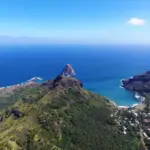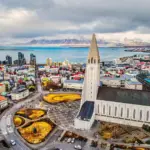
Have you heard of the famous Death Road in Bolivia? This is one of the most incredible and challenging adventures you can find in the stunning Andean Mountains. With unique characteristics and a rich history, the Death Road is a must-see attraction for those who love nature and are looking for an exciting experience.
In this article, we'll explore everything about this fascinating journey. From the discovery of Death Road until the risks and challenges involved, going through natural beauty of Andean Mountains and the tips to ensure a safe adventure, you will find all the information you need to prepare for this unforgettable experience.
Main Conclusions
- The Death Road in Bolivia is one of the most exciting and challenging adventures for mountain lovers. nature and of the Andean Mountains.
- The journey along Death Road involves risks and challenges, but with precautions and tips certain, it is possible to guarantee a safe adventure.
- In addition to the adrenaline, Death Road also offers a stunning natural landscape and an immersion in culture Bolivian.
- THE ecotourism can play an important role in preservation of the Andean Mountains and the Death Road.
- Death Road is a source of lessons valuable, inspiring courage and resilience.

Discovering the Death Road
Welcome to the thrilling journey of discovery along Bolivia's Death Road. Also known as "Camino de la Muerte," this impressive road stretches for about 60 km between the cities of La Paz and Coroico, in a region characterized by canyons, cliffs, and mountains.
Although it is known as one of the most dangerous roads in the world, the Death Road attracts adventurers from all over the world who seek a exciting experience in the midst of nature lush.
Its construction was conceived in 1930 and, for many years, it was the only connection between the two cities, but nowadays it is mainly used by the most courageous sportsmen and tourists.
Its characteristic tropical climate, with heavy rainfall in the rainy season and intense fog in winter, makes the journey even more exciting and challenging.

Unique features
The Death Road is a true challenge for anyone who dares to take it on. Stretching for about 60 kilometers, the road features a series of winding curves and narrow stretches, cutting through the hills and mountains along the way.
Furthermore, the road is surrounded by dense green forests, waterfalls, and incredible mountain views. natural beauty in the region is one of the main attractions of the Death Road.
While the road has become a popular destination for adventurers, it is important to note that the journey represents challenges considerable. Many brave travelers have gotten lost along the way, so it's recommended to make the journey with an experienced guide to ensure complete safety.
The Natural Beauty of the Andean Mountains
The Andean Mountains are one of the most beautiful mountain ranges in the world. Their unique geological formations and rich diversity of flora and fauna make them of this region truly special.
On Death Road, travelers have the opportunity to appreciate this natural beauty in all its glory. Along the way, you'll see majestic mountains, deep valleys, crystal-clear rivers, and stunning waterfalls.
Among the animal species that inhabit these altitudes are llamas, alpacas, condors, and pumas. Furthermore, the region boasts a wide variety of plants and flowers, many of which are endemic and can only be found in the Andean Mountains.

Risks and Challenges on Death Road
For many adventurers, traveling Bolivia's Death Road is a thrilling and unique challenge. However, it's important to be aware of the risks involved and take the necessary precautions during the journey.
The dangers of Death Road
With its steep cliffs, sharp curves, and narrow stretches, Death Road is considered one of the most dangerous roads in the world. Weather conditions can also be unpredictable, with frequent rains increasing the risk of landslides and avalanches. Furthermore, the altitude can cause discomfort and breathing difficulties in some people.
Precautions for a safe journey
To ensure a safe adventure When traveling on the Death Road, it's crucial to choose a reliable and experienced tour company. Make sure the company provides adequate safety equipment, such as helmets and gloves, and that the vehicle is in good condition. Passengers should also follow the guide's instructions and never exceed the speed limit.
Another way to minimize risks is to travel with a specialized guide. These professionals know the road and know how to handle any unexpected situations. It's also important to be well prepared physically, and if you have any health conditions, it's recommended to consult a doctor before embarking on this trip.
Opportunity for an unforgettable adventure
Even with the risks involved, the Death Road is an opportunity for an unforgettable adventure. If you're willing to take on this challenge, the road will reward you with incredible views of the Andean mountains and a breathtaking experience. With the right precautions, you can make the most of this thrilling journey.
Tips for a Safe Adventure
If you plan to explore Bolivia's Death Road, it's essential to be prepared and take precautions to ensure a safe and enjoyable experience. Here are some tips important to help you make the most of your adventure:
- Choose Reliable Travel Agencies: Make sure you choose a reliable and experienced travel agency for your trip. Do your research and read reviews from other travelers before choosing. Ensure the agency has all the necessary licenses and permits.
- Prepare Properly: Make sure you're physically prepared for the adventure and bring appropriate clothing and equipment. Remember to bring warm, waterproof clothing for the changing weather conditions along the way.
- Don't Risk It: While this adventure is thrilling, don't risk your life. Follow all tour guide instructions and avoid reckless behavior.
- Be Careful with Altitude: Death Road is located at high altitudes, so it's important to be prepared for potential negative health effects. Stay hydrated and avoid alcoholic beverages before and during your adventure.
- Bring a First Aid Kit: Be prepared for emergencies and carry a first aid kit with you. Be sure to include medications for nausea and headaches.
With these valuable tips, you're ready to explore Death Road safely and make the most of this thrilling adventure in the Andean Mountains.
Bolivian Culture Along the Death Road
By embarking on the Death Road, visitors have the opportunity to experience the rich Bolivian culture. The road passes through towns and cities that hold a lot of history and tradition.
The local cuisine is one of the highlights of the trip, with typical dishes prepared with fresh ingredients and unique flavors. Be sure to try the maní soup, chicharrón, and the traditional pique macho.
But the Bolivian culture It's not just about the cuisine. In many of the villages along the road, visitors have the opportunity to discover traditional crafts, such as the famous textiles produced by the women of the La Paz region.
Furthermore, the music and dance are also an important part of Bolivian culture. Many towns maintain folk traditions that are passed down from generation to generation, such as the Morenada dance and Andean music played on flutes and charangos.
The Importance of Preserving Bolivian Culture
Preserving Bolivian culture is essential to maintain long live history and the traditions of a people. To visit In these towns and cities along the Death Road, visitors have the opportunity to learn more about Bolivian culture and appreciate its importance.
Furthermore, tourism can be an important source of income for local communities, encouraging preservation of culture and sustainable development of the region.
The Role of Ecotourism in Preservation of the Andean Mountains
Bolivia's Death Road is a unique tourist attraction that offers visitors a breathtaking experience. However, preservation of the region is essential to maintain the natural beauty and avoid damage to local fauna and flora. That's where the role of ecotourism is essential, as it can help in the conservation of the Andean Mountains in all their richness and complexity.
THE ecotourism involves the conscious and sustainable exploitation of the environment, taking into account local communities and their needs. By visit Death Road, it is possible to enjoy the region without causing significant impacts to the environment, by choosing responsible tourism agencies that follow ecological and ethical practices.
Furthermore, ecotourism can have a positive impact on local communities, supporting their economies and providing employment and income opportunities. By choosing local tourism companies, visitors can contribute to the preservation of unique cultures and traditions while helping to minimize the negative effects of tourism in remote or less developed areas.
Therefore, ecotourism plays a very important role in preserving the Andean Mountains and the Death Road, allowing their continuity. natural wonders in its original state. By choosing sustainable tourism, visitors can make a difference in terms of environmental and cultural conservation, protect endemic species, and maintain natural beauty of the region for future generations.

The Best Time to Visit Death Road
If you plan visit the Death Road in Bolivia, it is important to choose the best time of the year to make the most of your adventure. The Andean Mountains region is characterized by a highland tropical climate, with two well-defined seasons: the dry season and the rainy season.
The dry season, which runs from May to October, is considered the best time to visit Death Road. During this period, the weather is milder, with average temperatures of 15°C and little to no rain. This provides ideal conditions for enjoying the stunning views and safely cycling down.
The rainy season, on the other hand, runs from November to April and is characterized by constant and intense rainfall. These weather conditions make Death Road more dangerous and challenging, with a high risk of landslides and collapses. Therefore, it is highly recommended to avoid Death Road during this period.
Furthermore, it's important to remember that Bolivia's peak tourist season is between June and August. During this period, Death Road can be crowded, making the experience less enjoyable. On the other hand, the low season, between December and March, can offer more affordable prices, but with the risk of heavy rains.
In short, the best time The best time to visit Death Road is during the dry season, between May and October. During this period, the weather conditions are most favorable for an exciting and safe adventure.
Alternatives to Death Road
If you want to enjoy a thrilling adventure in the Andean Mountains but prefer to avoid the risks involved in the Death Road, don't worry. There are several alternatives that offer similar experiences in terms of natural beauty and challenges.
Salkantay Trek, Peru
The Salkantay Trek is a challenging trail in Peru that can take adventurers to some of the most spectacular views of the Andes Mountains. Lasting approximately five days, the trek offers the opportunity to see the majestic Salkantay Mountain, the second-highest in the region, as well as enjoy crystal-clear lagoons and tropical forests. The trek is suitable for those seeking a moderate challenge, but with lower risk levels than those found on the Death Road.
La Cumbrecita, Argentina
La Cumbrecita is a small village in Argentina surrounded by spectacular mountain trails. With its unique architecture and spectacular scenery, the town is a popular destination for those looking for exciting hikes and breathtaking views. There are several trails ranging in difficulty, from easier hikes for beginners to more challenging trails for those seeking a greater challenge.
Colca Canyon, Peru
Colca Canyon is one of the deepest canyons in the world, located in southern Peru. At over 3,000 meters deep, it's a popular destination for tourists seeking thrilling challenges and incredible scenery. The trail typically takes two days to complete and is suitable for those seeking a moderate challenge. During the hike, you can spot local wildlife and enjoy incredible views.
Torres del Paine, Chile
The Park Torres del Paine National Park is a popular hiking and trekking destination in Chilean Patagonia. With a wide variety of trails, from short walks to longer treks, the park offers spectacular views of the region's mountains, lakes, and glaciers. While the W trail is the most popular, there are other routes that offer a similar experience, including the complete park circuit.
Learn from the Road of Death: Lessons in Courage and Resilience
The Road of Death it is an experience that can teach valuable lessons lessons on courage and resilience in the face of extreme challenges. By venturing on this incredibly challenging road, travelers have the opportunity to face their fears and overcome seemingly insurmountable obstacles. This experience can help strengthen resilience emotional and mental, allowing people to better cope with life's difficulties.
Furthermore, the road can also teach the importance of adequately preparing for dangers and risks. This includes choosing experienced and trustworthy guides and equipping yourself with appropriate safety equipment. Learning to assess risks and take necessary precautions is a valuable skill that can be applied to many aspects of life.
Another important lesson the Death Road can teach is the importance of collaboration and mutual aid. Travelers on this road often need to work together to overcome obstacles and face risky situations. This team mentality can be applied to many other areas of life, including teamwork and building collaborative relationships.
Ultimately, Death Road can teach us the importance of making the most of every moment in life. The stunning views and the sense of accomplishment upon completing the road are memories that will last a long time. Learning to appreciate these moments of beauty and fulfillment can help foster a positive and optimistic attitude toward life.

Conclusion: DEATH ROAD BOLIVIA, Adventure and Beauty in the Andean Mountains
By the end of this article, you'll have discovered Bolivia's incredible Death Road and become familiar with the wonders of the Andean Mountains. We hope this has awakened your adventurous spirit and inspired you to explore this stunning region. Prepare for an unforgettable experience in this natural challenge.
FAQ
What is the Death Road in Bolivia?
The Death Road is a famous route in Bolivia, known for its danger and challenges. It cuts through the Andean Mountains and offers spectacular scenery.
What is the location of Death Road?
The Death Road is located in Bolivia, connecting the city of La Paz to Coroico. It runs through the Andean Mountains, offering incredible views.
What are the risks involved on Death Road?
Death Road presents many hazards, such as sharp curves, lack of side protection, and adverse weather conditions. It's important to be prepared and follow all safety precautions.
When is the best time to visit Death Road?
The best time to visit Death Road is during the dry season, between May and October. During this period, the weather conditions are more favorable and the chance of rain is lower.
Is there a less risky alternative to Death Road?
Yes, there are other scenic and challenging routes in the Andean Mountains that can offer experiences similar to Death Road, but with less danger. It's important to research and choose the option best suited to your comfort and skill level.
What are some safety tips for traveling Death Road?
Some important tips are: hire a reliable travel agency, use appropriate safety equipment, be prepared for changing weather conditions, respect traffic rules, and follow the guides' instructions.
What can we learn from Death Road?
The Road of Death can teach us lessons valuable about courage and resilience. It shows us the importance of facing challenges, overcoming fears, and adapting to adversity. It's an inspiring and transformative experience.
What is the role of ecotourism in preserving the Andean Mountains?
Ecotourism plays a fundamental role in preserving the Andean Mountains and the Death Road. By promoting sustainable and responsible tourism, we can help preserve nature, support local communities, and ensure the conservation of this unique environment.
Lucas Wanderlust has a tireless spirit of adventure, always seeking new travel experiences. Fascinated by the world and the possibility of exploring unknown destinations, he fell in love with the sense of freedom and self-discovery that traveling alone provides. With a backpack on his back and a heart open to the unknown, Lucas embarks on exciting journeys, where each destination becomes a unique chapter in his life story. He gives himself body and soul to the magic of solo travel, inspiring others to follow in his footsteps and discover themselves through adventure.







